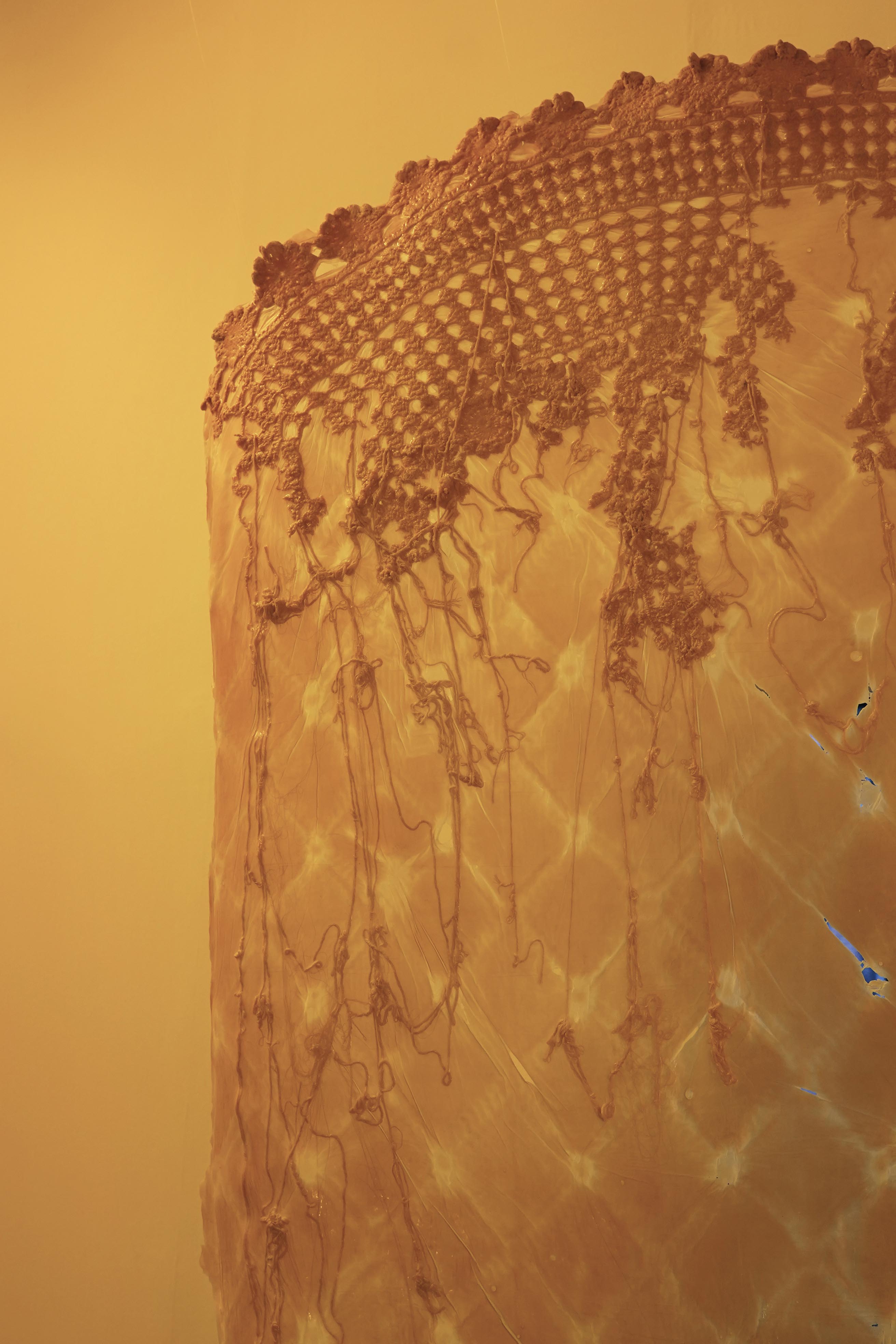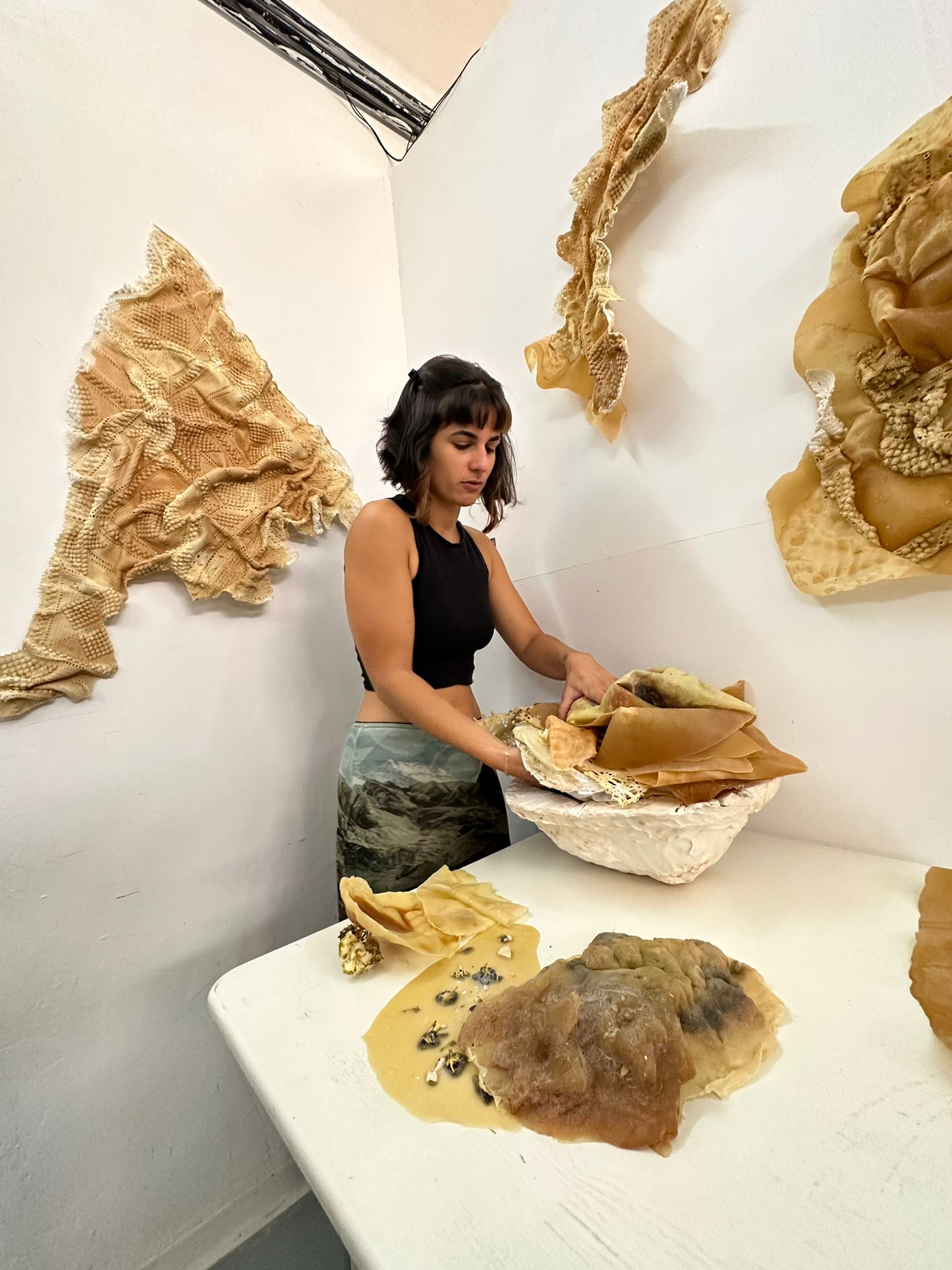Visiting Madrid-based artist Maya Pita-Romero’s studio is like stepping into a micro universe populated by peculiar beings of all shapes and sizes. Everything in her studio is alive somehow, in a bubbling, sticky, perturbing-yet friendly way.
I met the artist at the entrance of Servicios Generales, a collaborative project space she shares with some of her artist friends. Coming from a background in Fine Arts at Escuela Tai, Maya was a resident at Casa Antillón during Autumn of 2023, opening a solo exhibition at El Chico Gallery and the end of the same year. In her installation and sculptures, the artist explores unsettling, viscous imaginaries that probe present-day relationships and forms of consumption, as she explains to me over coffee and freshly baked brownies. Her practice signals a way towards care and sustainability, also in art: “If we're striving to create more ecological forms of life, It doesn't make much sense for artworks to be preserved for hundreds of years.” As we talk, I begin to perceive her work as an ongoing process, a living being in itself. The journey begins within her fridge, which is packed with pots and jars filled with all kinds of decaying substances, ready to be transformed into three-dimensional pieces. Her sculptures, carved from organic materials like cotton and seeds, fill the space with their unsettling presence, an entanglement of latex and polyester flowers. Even the family bed sheets intertwined in her most recent pieces project the creative principle inherent in her practice: sheets as a second skin, and skin as means of protection, passed down from one generation to the next.
Hers is an ode to all that is slimy, slippery, and strangely succulent in the most radical of ways. Here’s a taste of it:

@ Goro Studio
Dear Maya! Your art has taken on many different forms in recent years, moving from painting to sculpture, installations, and mixed media. Can you tell us how this shift happened and what inspired it?
I don’t think I can include painting as part of my practice, but rather as something that led me to pursue artistic creation. Having explored the world of painting to some extent, I felt that I couldn't express myself fully from there, so I began constructing volumetric pieces. My interest in new materials and biomaterials also drove me to create pieces that transcend the two dimensions. This led me to create sculptural pieces, while also considering the spatial dimension. It also sparked my interest in creating something installation-based, as well as to blend different artistic languages.
Your practice is one crazy mix! Who are your main references? In your studio, you mentioned many…
I always like to have my references, or simply things that catch my attention, at hand, whether they are books, artists, movies, textures, or even plants.
I tend to gravitate towards references that are visceral and viscous, such as the work of Mire Lee, a Korean artist whom I've been closely following lately. Other artists that I'm also a fan of include Sarah Lucas, Mónica Mays, and Eva Fábregas. I'm also a bit of a freak of Cronenberg, although sometimes I find it a bit challenging to watch his movies due to how gore they are. However, I'm fascinated by the philosophy and concepts behind them. They make me think.
Lately, I've been reading Marosa Di Giorgio, as I thought it would be a somewhat lighter read, but after going through her work, I find myself thinking for quite some time, and I like that. I believe that, from what I've read, I would also consider Ariana Reines, Donna Haraway, Octavia E. Butler, Rebecca Tamás as influences.

Let's talk about materials. Why do you tend to the organic, the perishable, even the repugnant?
I'm interested in the pieces being alive somehow, and not ending up as just another waste. I believe that, in present times, it doesn't make much sense for artworks to be preserved for hundreds of years as we've been doing all this time. If we're striving to create more sustainable and ecological forms of life, I understand that art cannot escape that. This has led me to work with organic materials and, consequently, with the decaying or the repugnant. It's something we're not accustomed to seeing, and I think that, in a way, it terrifies us a little.
Beyond trying to be eco-friendly, it's a process that I also enjoy. I like observing how the textures and colors of organic materials change, how they react to the environment. More than once, I've had to deal with mosquito infestations and fungi, but the colors of the mold are amazing.

@ Sergio Pradana
Your pieces vary considerably depending on where they were created, influenced by humidity and other environmental conditions. Are you specifically drawn to this mutability? Do you design your pieces with specific environments in mind?
I think it's a consequence of the materials I usually use, since they are quite unpredictable and dependent on environmental factors. For instance, some materials dry much faster in summer than in winter, and the result is different. Many times, I feel like I work for the material, not the material for me, which I find very interesting. Allowing it to act on its own, observing and seeing how it adopts rhythms of production different from mine.
Having investigated the relationship between cotton cultivation and the menstrual cycle in “Marañas que lamen mi piel” (2022), did you mean to put forth a broader reflection on modern-day production? In particular, did you mean to research this in relation to gender bias?
These are themes present in this project, regardless of my main intention. Touching on the topic of menstruation, it's inevitable to think about the mass production of period products such as tampons and pads, which are neither good for our health nor the planet. It takes a lot of cotton to manufacture them, and every month we need to purchase these products. Although other options, like menstrual cups, emerged in the late 19th century, they haven't been as well-known until recent years. They are more durable, environmentally friendly, and better for individuals who menstruate.
For this project, my research focused more on aspects related to both plant and human cycles that end up intertwining due to aseptic care, both for the body and fields. As mentioned earlier, menstruation is a topic that has been widely discussed and advocated for many years, carrying numerous connotations. However, at least in this project, I believe it made more sense to speak about bodies rather than genders.

In the studio you said that you had 'massaged' these sculptures with pesticides, a tactile component I find very interesting. Is it important for you to physically engage in the process of creating your works? Do you believe there is an element of performativity in this?
In these particular pieces, I believe there is a certain performativity, beyond the fact that they were created almost without any tools or utensils. When I used the pesticide, it was a rather calm moment. I took my time, as if I were caressing something. I also thought about the life of the pieces, picturing myself almost as a caretaker who was tending, ironically, with toxic substances. Similarly to what happens in cotton cultivation, which is "nurtured" with chemicals.
In general, I tend to work a lot with my hands. This way, I better understand the materials by being in direct contact with them, and I feel closer to the piece I am creating. Sometimes, using tools to handle materials that have or appear to have life feels almost violent to me.

@ Sergio Pradana
Given the sensual aspect of your work, what importance do you give to the audience’s reaction? Do you mean to activate a sensory relationship between the pieces and visitors?
I am interested in creating a sense of estrangement, whether through texture, smell, or form. I aim to produce pieces that compel you to touch or approach them closely to truly understand what and how they were made.
Often, due to their more visceral aesthetic, they may evoke initial discomfort, but I believe there is also a certain fascination with the strange or the abject. I have experienced this discomfort myself. Yet, being intimately involved in the creation process, I come to see it as something beautiful, which is what I hope the viewer ultimately discovers in the pieces.
Having also incorporated cotton blankets woven by your great-grandmother, would you say you are drawn to elements traditionally associated with feminine craft, such as caregiving and embroidery? Is there a reason you chose an object that belonged to your own family?
The discovery of my great-grandmother's blankets coincided with the time I started working with cotton, and intuitively, I felt a strong connection to my work. Additionally, as I mentioned earlier, I try not to generate too much waste and prefer to reuse things. Since no one was using these blankets anymore, what better way to give them a new life?
Caring is a recurring theme in my practice, and this led me to think of the blanket as a symbol of protection and care. I consider this traditional practice as a form of caring, as my great-grandmother knitted these blankets for my grandmother, my mother, and my aunt.
Currently, I continue to explore the meaning of this practice and these objects from various perspectives, blending them with other materials as well. I now see these blankets more as second skins that we construct.

In your recent works, you've been exploring latex, an element that attracted you for its symbolism and biological qualities. Can you further explain this attraction, and how you have integrated this material into your practice?
I arrived at latex starting from the blankets, by interpreting them as a second skin. Plants that produce latex expel it when torn or punctured. This liquid, upon drying, forms a protective layer over the wound, somewhat akin to a second skin.
I connected the idea of bodily injury and the abuse of the body with this defense mechanism of plants. So, I began experimenting with latex to understand the material better and explore its potential in relation to textiles.
On the other hand, latex is an organic material derived from plants. However, the form in which we purchase it has already been processed in some way or synthetically manufactured. Initially, I wanted to stay true to the idea that all my work should be organic and perishable, and I struggled with the idea of using latex. Until I realized that what was also crucial for me were materials that change over time, as in this case, and that aligns with the overall narrative.
Where do you envision your artistic practice heading in the future? You mentioned blending writing with audio and exploring immersive artworks…
I'm not entirely sure where my work is heading. I still have many doors open to continue shaping the path. And, of course, I am eager to keep going and see where I end up. Lately, I am drawn to writing and trying new mediums, also to step out of my comfort zone because otherwise, it seems dull to me. On a more theoretical level, it is a bit challenging for me to predict what I will research in the future. Many things stem from sometimes serendipitous discoveries, although there are always underlying interests. I am excited to see what new things I discover and to keep exploring new paths.
Words & photos by Whataboutvic.



@Goro Studio



@ Goro Studio

@ Roberto Ruiz

